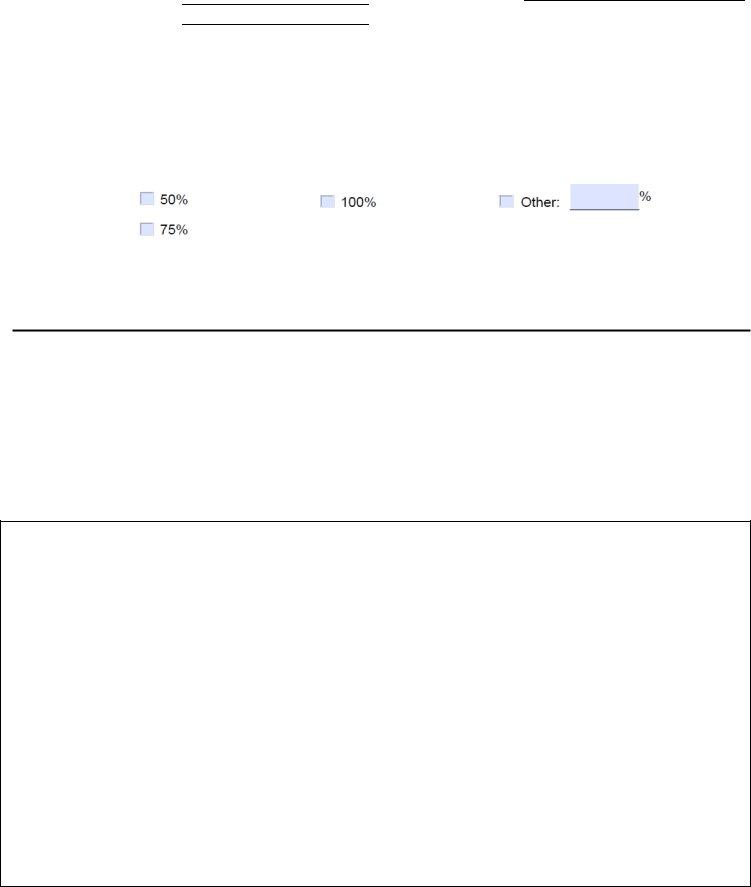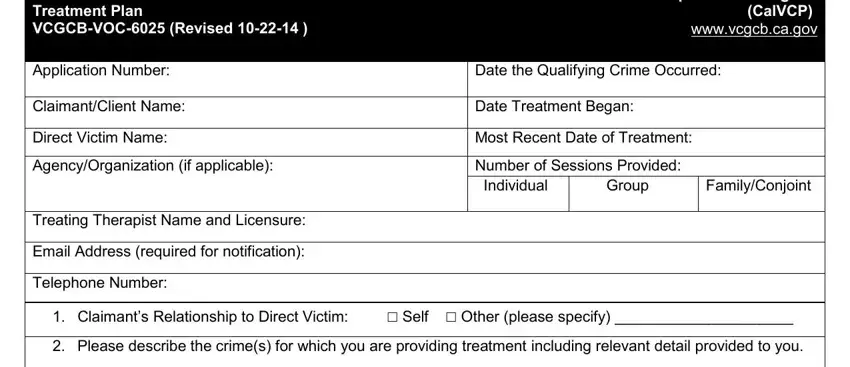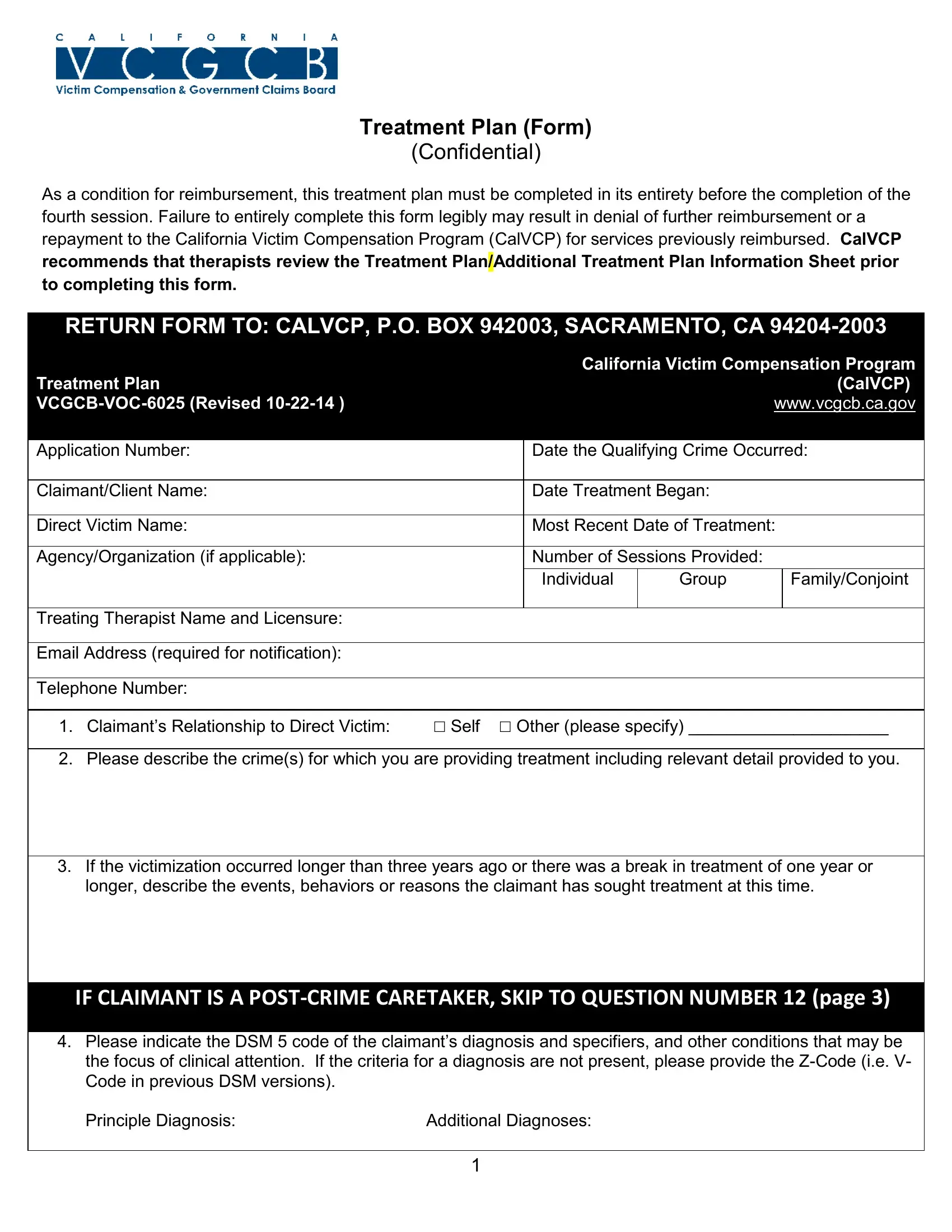Treatment Plan (Form)
(Confidential)
As a condition for reimbursement, this treatment plan must be completed in its entirety before the completion of the fourth session. Failure to entirely complete this form legibly may result in denial of further reimbursement or a repayment to the California Victim Compensation Program (CalVCP) for services previously reimbursed. CalVCP
recommends that therapists review the Treatment Plan/Additional Treatment Plan Information Sheet prior to completing this form.
RETURN FORM TO: CALVCP, P.O. BOX 942003, SACRAMENTO, CA 94204-2003
|
|
|
|
|
|
|
|
|
|
|
California Victim Compensation Program |
|
|
|
|
|
|
Treatment Plan |
|
|
|
|
(CalVCP) |
|
|
VCGCB-VOC-6025 (Revised 10-22-14 ) |
|
|
|
www.vcgcb.ca.gov |
|
|
|
|
|
|
|
|
|
|
|
|
|
|
|
|
|
Application Number: |
Date the Qualifying Crime Occurred: |
|
|
|
|
|
|
|
|
Claimant/Client Name: |
Date Treatment Began: |
|
|
|
|
|
|
|
|
|
Direct Victim Name: |
Most Recent Date of Treatment: |
|
|
|
|
|
|
|
|
Agency/Organization (if applicable): |
Number of Sessions Provided: |
|
|
|
|
|
|
|
|
|
|
|
|
|
Individual |
Group |
|
Family/Conjoint |
|
|
|
|
|
|
|
|
Treating Therapist Name and Licensure:
Email Address (required for notification):
Telephone Number:
1.Claimant’s Relationship to Direct Victim: ☐ Self ☐ Other (please specify) _____________________
2.Please describe the crime(s) for which you are providing treatment including relevant detail provided to you.
3.If the victimization occurred longer than three years ago or there was a break in treatment of one year or longer, describe the events, behaviors or reasons the claimant has sought treatment at this time.
IF CLAIMANT IS A POST-CRIME CARETAKER, SKIP TO QUESTION NUMBER 12 (PAGE 3)
4.Please indicate the DSM 5 code of the claimant’s diagnosis and specifiers, and other conditions that may be the focus of clinical attention. If the criteria for a diagnosis are not present, please provide the Z-Code (i.e. V- Code in previous DSM versions).
Principle Diagnosis: |
Additional Diagnoses: |
1
5.Please describe the symptoms/behaviors that will be the treatment focus and interventions you will use to treat each symptom/behavior.
Symptom/Behavior: _________________________ Intervention: _________________________________
Symptom/Behavior: _________________________ Intervention: _________________________________
Symptom/Behavior: _________________________ Intervention: _________________________________
6.Level 1 Cross-Cutting Symptom Measure (Please refer to pages 734-741 of the DSM 5.)
Adults
Domain |
Highest |
Domain |
Highest |
|
Score |
|
Score |
|
|
|
|
I. |
|
VII. |
|
|
|
|
|
II. |
|
VIII. |
|
|
|
|
|
III. |
|
IX. |
|
|
|
|
|
IV. |
|
X. |
|
|
|
|
|
V. |
|
XI. |
|
|
|
|
|
VI. |
|
XII. |
|
|
|
XIII. |
|
|
|
|
|
Children
Domain |
Highest |
Domain |
Highest |
|
Score |
|
Score |
|
|
|
|
I. |
|
VII. |
|
|
|
|
|
II. |
|
VIII. |
|
|
|
|
|
III. |
|
IX. |
|
|
|
|
|
IV. |
|
X |
|
|
|
|
|
V. |
|
XI. |
|
|
|
|
|
VI. |
|
XII. |
|
|
|
|
|
7.Please identify any standardized tests you will use to measure treatment progress (e.g. PTSD Checklist, Child Behavioral Checklist, Youth Self Report, Beck Depression Scale, WHODAS, etc.)
8.FOR ADULTS: Please describe any factors you believe may adversely affect treatment progress. Consider factors such as inadequate housing, employment, physical health, transportation, child care and social network.
9.FOR CHILDREN: Please describe any factors you believe may adversely affect treatment progress. Consider such factors as living circumstances, inadequate caretakers, educational or developmental delays and peer support network.
10. Do you expect the claimant to have further contact with the legal system in regard to the qualifying crime?
☐Yes ☐ No
If answer is yes, please explain:
11. Was the perpetrator of the crime released from custody?
Month Year
☐ Yes – If “yes” please provide the date the perpetrator was released from custody ______/______
☐No
☐N/A
12.Do you expect the claimant will be subject to uninvited or unwelcome contact with the alleged suspect that is not court authorized?
☐Yes ☐ No
If answer is yes, please explain:
13.If the claimant is a post-crime caretaker (i.e., foster parent, relative caretaker), please list and describe the interventions aimed at alleviating the direct victim’s symptoms.
Direct Victim’s Symptoms/Behaviors |
Interventions for the Post-Crime Caretaker |
14.Has the claimant terminated treatment (i.e. claimant not returning for treatment at this time)?
☐Yes ☐ No
Date of termination _____________

If the victim's offender is convicted, CalVCP will request the criminal court to order the offender to pay restitution to reimburse CalVCP for any expenses CalVCP has paid for this crime. As a treating therapist you may be required to testify in a restitution hearing that the mental health counseling services you provided were necessary as a direct result of the crime at the percentage indicated below. Please Note: CalVCP can only pay for the percentage of treatment that is necessary as a direct result of the crime for which the application was filed.
In your opinion, what percentage of your treatment is necessary as a direct result of the qualifying crime?
If it is your professional opinion that subsequent treatment is not 100% related to the qualifying crime, the Treatment Plan must be submitted to CalVCP for review upon completion of the claimant's fourth session.
I declare under penalty of perjury under the laws of the State of California (Penal Code sections 72, 118, and 129) that:(1) I have read all of the questions contained on this form and, to the best of my information and belief, all my answers are true, correct and complete; and (2) all treatment submitted for reimbursement by CalVCP or pursuant to this form was necessary at the percentage noted above and as a direct result of the crime described above.
I understand that mental health counseling must be approved in advance, and that if treatment is provided without the required approval, CalVCP may not reimburse those expenses.
IMPORTANT: THIS DOCUMENT WILL NOT BE REVIEWED WITHOUT THE REQUIRED SIGNATURE(S) AND DATE(S) BELOW.
Treating Therapist:
Name: ________________________________________________ |
License No. _______________ |
(Please Print Clearly) |
|
Signature: _____________________________________________ |
Date: ____________________ |
If Treating Therapist Requires Supervision:
Supervising Therapist’s Name: _________________________________ License No. _______________
(Please Print Clearly)
Signature: _________________________________________________ Date: ____________________






